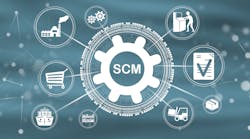Download this article in PDF format.
Known for its ability to assess and predict supply chain trends before those developments impact the broader marketplace, global research firm Gartner, Inc., recently released an updated list of top technology themes that all supply chain leaders and procurement organizations should be watching this year.
Gartner says its analysts selected the themes for their “transformational potential” and ability to foster operational resiliency across business functions, technology, and service delivery. “This year, we’ve decided to focus on broader, overarching technology themes rather than individual technologies,” said Christian Titze, VP analyst with the Gartner Supply Chain practice, in a press release. “This is because innovative technologies are often combined together in order to solve specific supply chain business problems.”
Top Themes to Know and Understand
According to Gartner’s The 2021 Supply Chain Technology Themes report, the top supply chain technology themes that organizations should be paying attention to and/or embracing right now include:
Hyperautomation. The combination of technologies such as machine learning (ML), artificial intelligence (AI), and robotic process automation (RPA), hyperautomation helps facilitate or automate tasks that originally required some form of human judgment or action. “Over the next 10 years, people and businesses will need to delegate more and more authority of decision making to intelligent applications, physical robots, and software service assistants,” Gartner states in its release. “Hyperautomation is expected to help automate transactional processes, such as order to cash and complex decision making, eventually augmenting human capabilities and supporting the creation of an autonomous supply chain.”
Digital Supply Chain Twin (DSCT). A digital representation of the physical supply chain, the DSCT is the basis for local and end-to-end decision-making for the supply chain. It also ensures that this decision making is aligned horizontally and vertically throughout the network. “The DSCT is derived from all the relevant data across the supply chain and its operating environment,” Gartner points out.
Immersive Experience and Applications. According to Gartner, immersive experience reimagines the user experience by enabling users to perceive and interact with the virtual world. Head-mounted displays (HMDs), wearables, smartglasses, 5G, and even smartphones or tablets provide the infrastructure and enhancements to immersive experiences through a mix of graphic processing, AI, and other individual business applications. “Immersive experience technologies have the potential to radically influence the trajectory of supply chain management. [They present] new interaction models through the product lifecycle, not only with humans, but with other processes, machines, and applications,” Titze said in the press release.
Edge Ecosystems. Comprising edge computing and edge data processing applications, edge ecosystems allow supply chain technology leaders to reassign and re-plan large swaths of data processing capacity to the edges of enterprises, where things and people produce or make decisions, Gartner explains. For example, the technologies can be used to track and monitor condition or temperature requirements across multiple phases of a product’s lifecycle.
Supply Chain Security. By bringing together a more comprehensive approach to embracing security risks (i.e., counterfeits or cybercrime) holistically across the end to end supply chain, scalable supply chain security technology solutions are helping companies go to battle against the bad actors that try to infiltrate their operations, networks, and other critical services.
Environmental Social Governance (ESG). “Global supply chains have a pivotal role to play in their contribution to both map and assess ESG risks and opportunities,” Gartner says, noting that current technologies enable the tracking of product origins (i.e., palm oil or soy) and align with corporate biodiversity and climate change goals. “Modern supply chains are highly connected and interdependent,” Titze said in the release. “Failure to invest in tools and solutions that govern, predict, and adapt to new ESG impacts could have a significant influence on brand or company image, customer value perception, and the cost and availability of goods.”
Embedded AI and Analytics. These software capabilities deliver real-time reporting, interactive data visualization, advanced analytics, and intelligence directly into an enterprise business application. “This stack of technologies can be used in warehousing, where mobile robot controls or intelligent robotic picking systems leverage their embedded analytics to further optimize operations,” Gartner explains.
Augmented Data Intelligence. Last but not least, augmented data intelligence enables the delivery of insightful information, predictions, and suggestions across the supply chain. “Technology leaders [need] solutions that help them increase visibility and generate insights from data,” Titze said in the release. “This is where augmented data intelligence comes in next to core business applications. These solutions have the capability to collect, correlate, and analyze several data pipelines and provide leaders with the information they need.”










